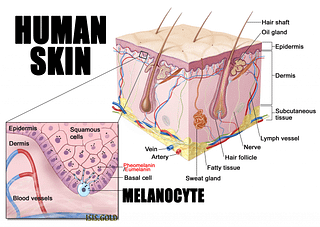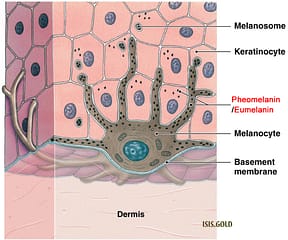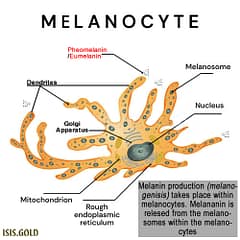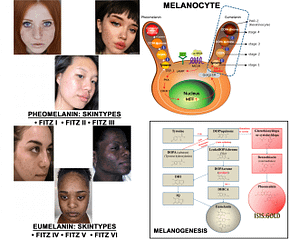
I will explain exactly how these skin whitening agents work to bleach our skin. This information will also help you choose the type of skin whitener that will benefit you the most. First you need to understand melanin: how it’s produced; the types of melanin that are produced; and what types melanin your skin type specifically produces. And please consult my Skin Bleach Buying Guide
MELANIN PRODUCTION
Melanin is a broad term for a group of natural pigments found in most organisms on earth. Melanin is produced through a multistage chemical process called melanogenesis, where the oxidation of the amino acid tyrosine is followed by polymerization. These melanin pigments are produced in a specialized group of cells called melanocytes.
MELANOGENESIS
Melanin is produced in melanosomes by melanocytes in a complex process called melanogenesis. The purpose of melanogenesis is to protect the hypodermis (under the top layer of skin) from damage by UV-B radiation. The color of the melanin determines how much of the UV-B light it can absorb, the darker the melanin the more UV-B light it can absorb and block it from passing through the epidermis. And the more UV-B light melanin can absorb, means more UV protection for the skin. Melanogenesis is a complex process with several different stages. The most important positive regulator of melanogenesis is the MC1 receptor with its ligands melanocortic peptides. As the figure shows (see photo), MC1R activates the cyclic AMP (cAMP) response-element binding protein (CREB). Increased expression of MITF and its activation by phosphorylation stimulate the transcription of tyrosinase (TYR), tyrosinase-related protein 1 (TYRP1), and dopachrome tautomerase (DCT), which produce melanin. Melanin synthesis takes place within specialized intracellular organelles called melanosomes. Melanin-containing melanosomes then move from the perinuclear region to the dendrite tips and are transferred to keratinocytes (top skin layer).
What Activates Melanogenesis?
Skin trauma, UV rays [sun bathing: a tan is a skin injury, it’s the result of the skin trying to defend itself from harmful UV rays], prescription meds, birth control (pill or shot), over-active hormones, sickness, allergies, and pregnancy can cause melanocytes to produce more melanin than they normally do. This results in overall skin darkening or localized hyper-pigmentation near the area of trauma. The releasing of extra melanin is also an immune response to skin trauma, the extra melanin (hyperpigmentation) acts as a bandaid that never peels off. In some people, melanocytes can be very over-reactive when the skin is irritated or slightly bruised, similar to an allergy [An allergy is the body’s immune system over-reacting to something that is virtually harmless {i.e. peanuts, pollen, etc.}. I suggest this type of individual to take 24,000mg MSM with 3000mg Vitamin-C daily, optionally you can add other Skin Whitening Pills to this regimen. This will help keep your skin from healing with dark marks from the simplest skin injury [e.g. you scrape knee or elbow] without the use of heavy skin bleach.
TYPES OF MELANIN
Most people speak of “melanin” as if it is some special exclusive dark tissue substance that only one type of people contain and produce. When in fact there are three different types of melanin. And melanin is produced by ALL humans, mammals, plants, and the entire animal kingdom – except for albinos.
Eumelanin: There are two types of eumelanin, which are brown eumelanin and black eumelanin. Those two types of eumelanin chemically differ from each other in their pattern of polymeric bonds. A small amount of black eumelanin in the absence of other pigments causes grey hair. A small amount of brown eumelanin in the absence of other pigments causes yellow (blond) hair. As the body ages, it continues to produce black eumelanin but stops producing brown eumelanin, resulting in the grey hair that is common in elderly people.
Pheomelanin: Pheomelanins impart a range of pigments, from yellowish to reddish colors. Pheomelanins are particularly concentrated in the lips, nipples, glans of the penis, and vagina. When a small amount of brown eumelanin in hair {which would otherwise cause blonde hair} is mixed with red pheomelanin, the result is orange hair {which is typically called “red” or “ginger” hair}. Redheads often have a more of pinkish hue to their skin, this is because of the pheomelanin their skin produces. In my article MSM Skin Whitening, I explain how your skin will start producing pheomelanin after taking 24,000mg MSM for 3 months. Your nipples lips and finger tips will start looking a healthy pretty pink after 3 months of MSM use.
Neuromelanin: Neuromelanin gives specific brain sections, such as the substantia nigra or the locus coeruleus, distinct color. It is a type of melanin and similar to other forms of peripheral melanin. Neuromelanin is insoluble in organic compounds, and can be labeled by silver staining. It’s called neuromelanin because of its function and the color change that appears in tissues that contain it {neuromelanin contains black/brown pigmented granules} Neuromelanin is found to accumulate while aging, noticeably starting after humans reach age 2–3 years old. Neuromelanin is believed to protect neurons {in the substantia nigra} from iron-induced oxidative stress. Neuromelanin is considered a true melanin due to its stable free radical structure and how it avidly chelates metals.
Albinism: is a genetic disorder that causes an organism to be born without any dermal melanocytes. Organisms effected with this genetic disorder aren’t able to produce any type of skin pigment at all. The absence of any pigmentation results in white hair/skin/feathers/scales and pink eyes {Some albino people/animals have pink colored eyes. The pink iris color is from the blood vessels in the eye being visible, because there is no pigment in the iris. Some Albinos have very little pigment in their irises, just enough to make the iris appear blue in color}. Albinism is seen in humans and the entire Animal Kingdom. According to the National Organization for Albinism and Hypopigmentation, about 1 in 18,000 to 20,000 people in the United States have a form of albinism.
WHAT DO THESE SKIN WHITENERS DO?
Please read my article SKIN WHITENERS EXPLAINED: WHICH IS THE STRONGEST? for a full description of each of the below skin whitening agents. And please use the Skin Bleach Buying Guide to further help you decide what skin whitening product is best for you.
REMOVES MELANIN
• Hydroquinone
• Mequinol
• Tetrahydroxycurcumin (high-purity turmeric Extract)
• Hydrogen Peroxide
Hydroquinone has one job, to remove melanin from everywhere (from the top layer of skin, and also removes melanin stored in the melanocytes but does not hurt or change melanocytes). HQ is absolute, it is guaranteed to remove hyper-pigmentation and whiten skin many shades whiter. But that is all HQ does… HQ won’t relieve, redness, inflammation, swelling, tighten skin, remove stretchmarks, or reduce wrinkles. You would have to pair HQ with one of the herbal skin whiteners to relieve those over issues. Mequinol is even stronger than hydroquinone. MEQ removes melanin (from the top layer of skin, and also removes melanin stored in the melanocytes but does not hurt or change melanocytes) and also disrupts all stages in the melanin production process. This is why MEQ causes a semi-permanent skin whitening effect. MEQ goes even harder than HQ, but won’t relieve, redness, inflammation, swelling, tighten skin, remove stretchmarks, or reduce wrinkles. You would have to pair MEQ with one of the herbal skin whiteners to relieve those over issues. Hydrogen Peroxide is an organic acid that also bleaches skin white. In very high doses (35%) hydrogen peroxide will burn skin to a crisp powdery white. Do not use high-dose hydrogen peroxide to bleach your skin unless you have experience working with this very caustic material. And never let hydrogen peroxide get in your hair or it will bleach it blonde, rinse it right away to prevent this.
DISRUPTS OR STOPS MELANIN PRODUCTION
• Mequinol
• Tranexamic Acid
• Arbutin
• Kojic Acid
• SepiWhite (Undecylenoyl Phenylalanine)
• Vitamin-C (ascorbic acid, terahexyldecl ascorbic acid)
• Astaxanthin
• Phloretin
• Licorice Extracts (glabridin, glycyrrhiza glabra, liquirin)
• Stilbenes (pterostilbene, resveratrol)
• Bioflavanoids (hesperidin, diosin, quercetin, etc.)
There are several steps that occur during melanin production (explained above). Herbal skin bleaching agents mostly work by disrupting the melanin production process {i.e. blocking tyrosine, a-MSH, etc}. If even one element/action/process is blocked or missing melanin production cannot happen. An individual will eventually get very light if their skin either stops producing melanin or their melanin production drops by a very large percent.
Exfoliation: As I explained to you all before, exfoliation is very important if you want to see results while using skin bleaching products. Not only because it removes dead skin so the skin bleach can penetrate. Exfoliation is also important because it is removes dead skin that is holding spent dead melanin and a host of other things {spent red & white blood cells, impurities, dust mite poop, burned off chemicals/medication/drugs, wax/oils, pretty much every thing you’ve done in the last 30-45 days is inside of that dead skin} this is one reason why your skin appears darker before it peels {the other reason is because it’s dead skin that has been fried by the chemical peel solution} and the skin revealed underneath is always several shades lighter. When using an herbal skin whitener that only effects melanin production {rather than removing/killing any melanin present} it is very important for you to fully exfoliate your skin in order to see any results at all. Melanin production has been stopped, therefore your skin will automatically become lighter because of this – but the existing melanin in your skin is still there, hyperpigmentation {normal skin turnover rate is 30-45 days, which is why you wouldn’t see much results if you don’t deep exfoliate with chemical peels} You get rid of that darkness by removing the layers of dead skin that’s holding that melanin, by fully exfoliating your skin with Saliclear (for body) and Tretinoin Gel 0.1% (for face).
DESTROYS THE ENTIRE MELANOCYTE
• Monobenzone {4-(Benzyloxy)phenol}
Monobenzone isn’t a skin whitener. It completely destroys the entire melanocyte causing the skin to be completely devoid of pigment, permanently. Monobenzone causes chemical vitiligo. When monobenzone is applied all over the body, it begins killing the melanocytes but not uniformly. This causes the person to loose color in patches over time, in the meantime they’ll look like a person that has really bad vitiligo {big white patches all over} until the monobenzone has killed off 100% of that person’s melanocytes. Even if monobenzone is only applied to one area {like the feet} white patches can still appear on other parts of the body. Which mean you cannot control monobenzone and how it works. Monobenzone doesn’t just destroy melanocytes, it seems to destroys the skin as a whole. I’ve seen the people who have used this harsh chemical to completely remove their melanin and they look absolutely terrible. Their skin looks translucent & traumatized, like a sick dying jellyfish. Their skin also looks a bit textured, crunchy, and patchy. Here at ISIS.GOLD I only promote beauty…I only formulate and sell products that enhance beauty. Monobenzone products will never be sold or promoted on ISIS.GOLD. If you skin has been damaged by monobenzone use, please purchase my Skin Consultation and please email your photos so I can help you heal your skin.



























